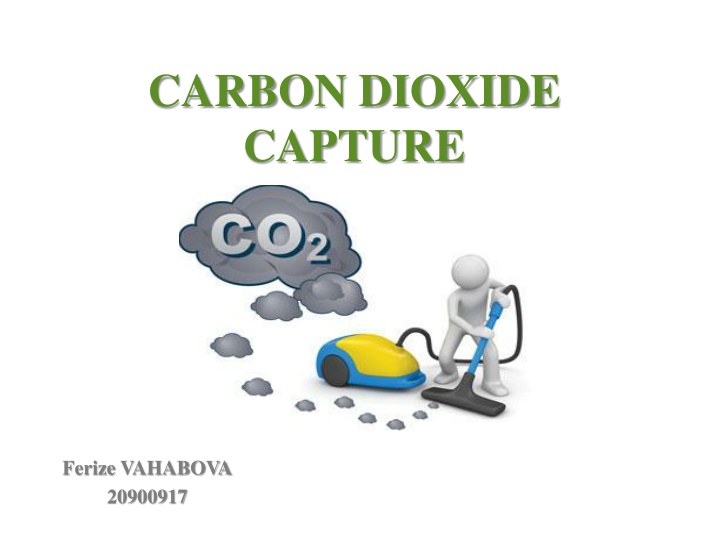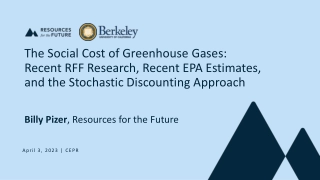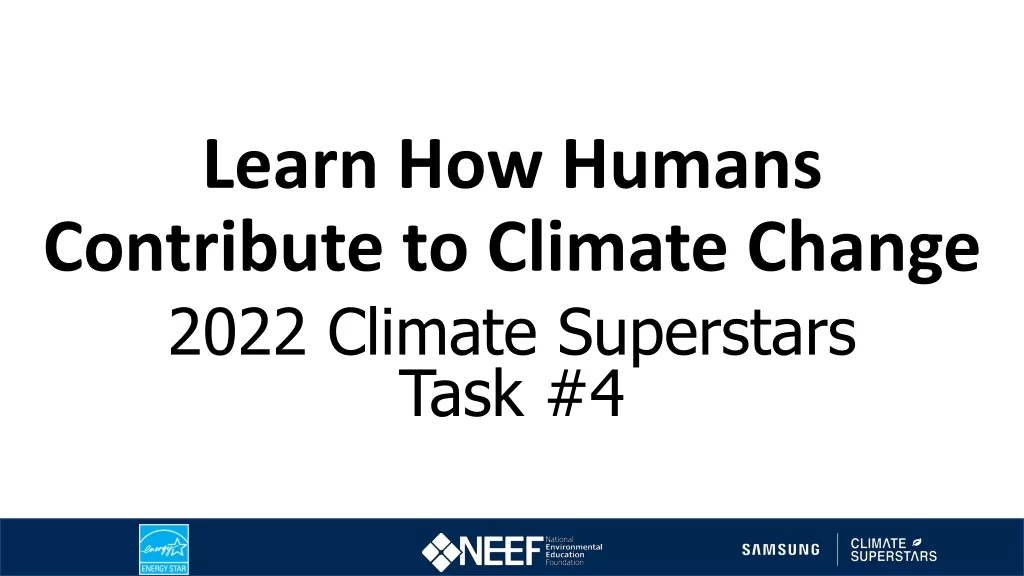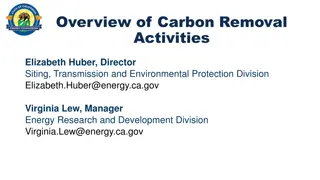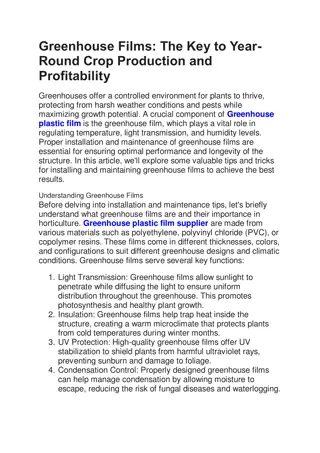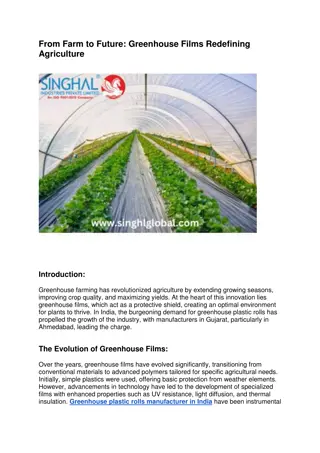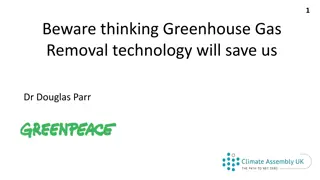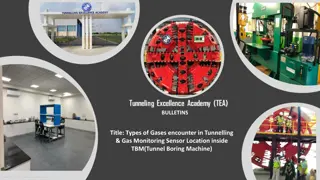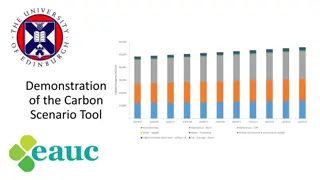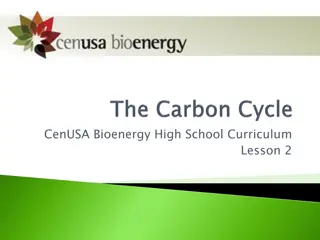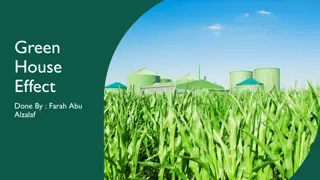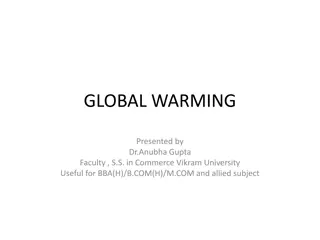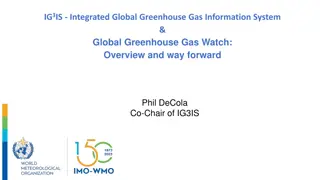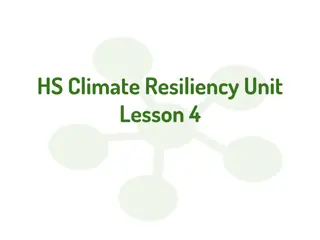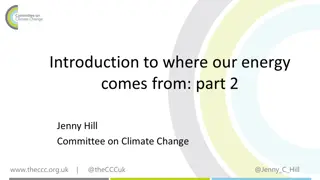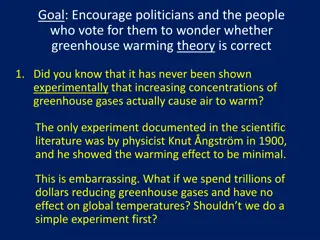Greenhouse Gases and Carbon Capture
Greenhouse gases like carbon dioxide, methane, and nitrous oxide contribute to the enhanced greenhouse effect, impacting global warming. Carbon capture and sequestration technologies offer solutions to reduce CO2 emissions from human activities, potentially mitigating climate change effects.
Download Presentation

Please find below an Image/Link to download the presentation.
The content on the website is provided AS IS for your information and personal use only. It may not be sold, licensed, or shared on other websites without obtaining consent from the author.If you encounter any issues during the download, it is possible that the publisher has removed the file from their server.
You are allowed to download the files provided on this website for personal or commercial use, subject to the condition that they are used lawfully. All files are the property of their respective owners.
The content on the website is provided AS IS for your information and personal use only. It may not be sold, licensed, or shared on other websites without obtaining consent from the author.
E N D
Presentation Transcript
CARBON DIOXIDE CAPTURE Ferize VAHABOVA 20900917
GREENHOUSE EFFECT Naturally occurring greenhouse gases normally trap some of the sun s heat, keeping the planet from freezing. Human activities, such as the burning of fossil fuels, are increasing greenhouse gas levels, leading to an enhanced greenhouse effect.
GREENHOUSE GASES Gases that trap heat in the atmosphere are called greenhouse gases (GHG). At the global scale, the key greenhouse gases emitted by human activities are: Carbon dioxide (CO2) Methane (CH4) Nitrous oxide (N2O) Fluorinated gases (F-gases)
GLOBAL CO2 EMISSION BY SOURCE Photo Source: Carbon Dioxide Information Analysis Center
GLOBAL CO2 EMISSION BY SOURCE Photo Source: Carbon Dioxide Information Analysis Center
GLOBAL CO2 EMISSION BY COUNTRY Photo Source: EDGAR 4.2FT2010 (JRC/PBL, 2012); BP, 2013; NBS China, 2013; USGS, 2013; WSA, 2013; NOAA, 2012
REDUCING CARBON DIOXIDE EMISSIONS Improving the insulation of buildings, traveling in more fuel- efficient vehicles, and using more efficient electrical appliances are all ways to reduce energy consumption, and thus CO2emissions. Energy Efficiency Reducing personal energy use by turning off lights and electronics when not in use reduces electricity demand. Reducing distance traveled in vehicles reduces petroleum consumption. Energy Conservation Producing more energy from renewable sources and using fuels with lower carbon contents are ways to reduce carbon emissions. Fuel Switching Carbon Capture and Sequestration Carbon dioxide capture and sequestration is a set of technologies that can potentially greatly reduce CO2emissions.
CARBON CAPTURE AND SEQUESTRATION IS a three-step process that includes: Underground injection and geologic sequestration of the CO2into deep underground rock formations. Transport of the captured and compressed CO2 Capture of CO2from power plants or industrial processes
CARBON CAPTURE AND SEQUESTRATION Photo Source: Cooperative Research Centre for Greenhouse Gas Technologies.
CARBON DIOXIDE CAPTURE METHODS Pre Pre-combustion CO2capture is a process where the carbon in the fuel is separated, or removed, before the combustion process. Combustion Post Post combustion CO2capture is a process where the CO2is separated, or removed, from a flue gas containing CO2mixed with other gasses, after the combustion process. Combustion Is very similar to post-combustion CO2capture. The main difference is that the combustion is carried out with pure oxygen instead of air. As a result the flue gas contains mainly CO2and water vapor, which can be easily separated. Oxyfuel combustion
PRE COMBUSTION METHOD Pre-combustion capture is applicable to integrated gasification combined cycle (IGCC) power plants, where solid fuel is converted into gaseous components ("syngas") by applying heat under pressure in the presence of steam and oxygen. Capture of the CO2 is currently accomplished an acid gas removal (AGR) process of absorption in a solvent. Photo Source: Global CCS Institute Co2 Capture Technologies Pre-Combustion Capture, January - 2012
TWO MAJOR TYPES OF ACID REMOVING SOLVENTS Chemical Absorbents: Chemical absorbents (e.g., MDEA and other amines) react with the acid gases and require heat to reverse the reactions and release the acid gases. These processes generally have lower capital for AGR than physical solvents, but use larger amounts of steam-heat for solvent regeneration. Physical Absorbents: Physical absorbents (e.g., Selexol, Rectisol) dissolve acid gases preferentially with increasing pressure. The absorbed acid gases are released from the solvent when pressure is decreased and temperature is increased. Significantly less steam-heat is required for solvent regeneration than with chemical solvents.
ADVANTAGE/DISADVANTAGE ADVANTAGES Synthesis gas is: DISADVANTAGES Pre-combustion is only applicable for new power plants because the capture process has to be an integrated part of the combustion process. Pre-combustion technologies like IGCC are not as mature as post- combustion capture technologies. Gas turbines running on hydrogen are a huge challenge. Concentrated in CO2 High pressure Resulting in: High CO2 partial pressure Increased driving force for separation More technologies available for separation Potential for reduction in compression costs/loads
POST COMBUSTION METHOD Post-combustion capture is primarily applicable to fossil fuel based systems such as conventional pulverized coal (PC)-fired power plants, where the fuel is burned with air in a boiler to produce steam that drives a turbine/generator to produce electricity. Photo Source: Bellona Environmental CCS Team
THREE CAPTURE METHODS Membranes - can separate CO2 from flue gas by selectively permeating it through the membrane material. The major challenge for membranes comes from the potential fouling of the membrane surfaces from particulate matter, uncertainty about the performance and cost of large-scale efficient vacuum pumps and compressors required for PCC, and the ability to integrate the process into a power plant. Adsorption - refers to uptake of CO2 molecules onto the surface another material for example, adhering CO2 molecules onto the surfaces of a solid sorbent such as 13X zeolites. Potential disadvantages for adsorbents include particle attrition, handling of large volumes of sorbent and thermal management of large-scale adsorber vessels. Absorption - refers to the uptake of CO2 into the bulk phase of another material. Today, absorption is a more mature technology than adsorption or membranes when it comes to post combustion CO2capture. The current proposed large- scale CO2capture plants are to be based on absorption.
ABSORPTON Amine Solvent Solution Capture Process is a standard industrial process for the production of CO2. Amine solution reacts with the CO2to form a weak acid and water-soluble salt. Chilled Ammonia Capture Process is an efficient and cost effective technology for CO2capture. Ammonia reacts with CO2to produce ammonia bicarbonate. Ammonia is also cheap and abundant, with a high CO2capacity and no degradation during the absorption / desorbtion process.
ADVANTAGE/DISADVANTAGE ADVANTAGE Can be retrofitted to existing plants It enables the continued deployment of the well established Pulverized Coal (PC) technology familiar to power industries worldwide The continued development of improved materials for Ultra Supercritical (USC) plants will increase the efficiency and reduce the CO2emissions of future PC plants The widespread R&D on improved sorbents and capture equipment should reduce the energy penalty of PCC capture. DISADVANTAGE Amine processes are commercially available at relatively small scale and considerable re-engineering and scale-up is needed Power Loss Most sorbents need very pure flue gas to minimize sorbent usage and cost. Steam extraction for solvent regeneration reduces flow to low- pressure turbine with significant operational impact on its efficiency and turn down capability. Water use is increased significantly with the addition of PCC particularly for water cooled plants.
OXYFUEL COMBUSTION In traditional fossil fuelled power plants combustion is carried out by using air, with the nitrogen (N2) in the air following the flue gas. An alternative is to use pure oxygen (O2) instead of air in the combustion. The advantage of this so-called oxyfuel technique is that the flue gas contains only steam and CO2. These two components are easily separated through cooling, by which the water then condenses and a CO2rich gas-stream is formed. The currently available technologies for pure oxygen-production are based primarily on cryogenic separation of air. Here the air is cooled down below the boiling point before the liquefied oxygen, nitrogen and argon are separated. However, the high amount of energy involved in this process make it a very expensive process. Promising on-going research to develop membranes that separate oxygen from air may drastically improve efficiently and lower capital investment costs.
OXYFUEL COMBUSTION FLOWCHART Photo Source: Global CCS Institute Co2 Capture Technologies Oxyfuel Combustion Capture, January - 2012
ADVANTAGE/DISADVANTAGE ADVANTAGE No chemical operations or significant on-site chemical inventory. Up to 100 percent CO2can be captured through this process. The best information available today (with the technology available today) is that oxy- combustion with CO2capture should be at least competitive with pre- and post-combustion CO2capture and may have a slight cost advantage. DISADVANTAGE It is not possible to develop sub- scale oxy-combustion technology at existing power plants. The combustion of fossil fuels and pure oxygen creates high material stress, hence the development of new materials is a prerequisite for deployment of this technology. It is expensive to produce pure oxygen, and research activities are ongoing worldwide to find new ways to produce oxygen.
R & D Solvents and Sorbents Solvents and Sorbents for CO2separation from flue gas can be further enhanced to reduce cost, improve reaction rates and regeneration loads, and eliminate contamination from other pollutants. Advanced Membranes Advanced Membranes for both oxygen-separation and CO2capture are key enabling technologies. Chemical Looping Chemical Looping processes that prevent direct contact of air and fuel offer the ability to produce a relatively pure stream of CO2that does not need to be separated from flue gas.
MEMBRANES Membranes can be used for separating CO2from other gas components. The technology is available today but will take some years and further research before it may be available for large-scale CO2capture at generation plant. Photo Source: Bellona Environmental CCS Team
CHEMICAL LOOPING Chemical looping is a new technology for combustion with inherent CO2capture. It is a significant departure from traditional combustion methods. It is flameless combustion technology combining two reactors, one air reactor and one fuel reactor. Photo Source: Bellona Environmental CCS Team
INTEGRATED FUEL CELLS Integrated fuel cells enable production of the clean energy carriers electricity and hydrogen from fossil fuel or bio-fuel with ultra-high efficiency and integrated CO2capture. Photo Source: Bellona Environmental CCS Team
ADSORPTION CO2capture by adsorption is not yet a mature commercial technology, but is currently being tested at a laboratory scale. Research programs are underway with advances in the technological expected, paving the way for adsorption as a future solution for CO2capture. Photo Source: The Cooperative Research Centre for Greenhouse Gas Technologies
POST-COMBUSTION CO2CAPTURE AND STORAGE, BRINDISI, ITALY. Photo Source: Enel Group
POST-COMBUSTION CO2CAPTURE PILOT PLANT, PUERTOLLANO, SPAIN. Photo Source: ELCOGAS S.A. IGCC Power Plant
OXYFUEL PILOT PLANT, SPREMBERG, GERMANY. Photo Source: Vattenfall AB
CARBON EMISSION IN TURKEY Turkey's CO2 Emissions by sector between 1990-2010 360,000.00 310,000.00 260,000.00 210,000.00 Energy 160,000.00 Differen tIndustries 110,000.00 Transportation 60,000.00 10,000.00 Other 1990 Cement 1995 2000 Total 2005 2006 2007 2008 2009 2010 Data Source: Turkiye Istatistik Kurumu
CARBON CAPTURE AND SEQUESTRATION IN TURKEY In 2009, a project named T rkiye'de Termik Santrallar ve Sanayi Tesislerinden Gelen Karbondioksit Emisyonu Envanterinin kart lmas ve Karbondioksitin Yeralt Jeolojik Ortamlarda Depolanma Potansiyelinin Belirlenmesi was held by ORTA DO U TEKN K N VERS TES PETROL ARA TIRMA MERKEZ (ODT PAL) and T RK YE PETROLLER ANON M ORTAKLI I (TPAO) The aim of this project was to determine the suitable places in Turkey for CO2 storage and to investigate the details of the project and make its economical analysis.
WHY CCS IS IMPORTANT? Carbon dioxide (CO2) capture and sequestration (CCS) could play an important role in reducing greenhouse gas emissions, while enabling low-carbon electricity generation from power plants. CCS could also viably be used to reduce emissions from industrial process such as cement production and natural gas processing facilities.
SEVERAL PLANTS WITH CCS PROJECTS FROM DIFFERENT CONTINENTS Data Source: Bellona Environmental CCS Team
REFERENCES http://www.epa.gov http://energy.gov http://www.globalccsinstitute.com http://cdiac.ornl.gov http://www.eie.gov.tr http://www.tuik.gov.tr http://www.enel.com http://www.elcogas.es http://corporate.vattenfall.com
THANKS FOR ATTENTION!
